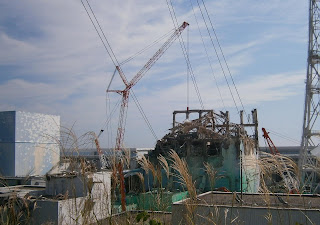Suzanne Hobbs has posted to the ANS Social Media list a link to an article that anyone interested in nuclear energy will find very thought provoking. It is also thought provoking for those interested in the high-level (fuel, that is) nuclear waste problem. The article describes the IFR, a plant that can actually be used to recycle waste into fuel.
We abandoned breeder reactor technology - a big step on the road to IFR technology and closing the nuclear fuel loop - some years back. In fact, the hard fight by the Joint Committee on Atomic Energy in the US Congress to get the Clinch River Breeder Reactor built, which the JCAE temporarily won, led to the all out push by environmentalists to disband the JCAE which (as I've commented here before) was the last single body in the government capable of providing leadership in the arena of nuclear energy. Sure enough, the Clinch River project got cancelled in the 80's.
From a post written by this author on this blog in June of this year:
The CRBR project was begun in the late 1960's by the AEC to develop a breeder reactor that would also produce a useful amount of energy commercially, and built on experiences gained from the EBR series of reactors and Fermi-1 near Detroit. Initial investigations and requests for bid proposals are mentioned in the "Nuclear Industry - 1969" volume produced by the AEC and the project was formally initiated in 1970. The project dragged out through developmental, budgetary and licensing problems for many years and was finally the subject of a bruising Congressional fight that began the end of the days of the JCAE and which led to the cancellation of the project for good in 1983.

Above, a 1973 illustration from APRA files showing the designed appearance of the CRBR project at that time. Below, the shot I used in June, showing the final designed site configuration.

This article makes you really want to see something get done on these lines; I strongly encourage everyone to read it.
CLICK HERE TO SEE THE ARTICLE ON BRAVE NEW CLIMATE.
6:02 PM Eastern Thursday September 29, 2011
ATOMIC POWER REVIEW
We abandoned breeder reactor technology - a big step on the road to IFR technology and closing the nuclear fuel loop - some years back. In fact, the hard fight by the Joint Committee on Atomic Energy in the US Congress to get the Clinch River Breeder Reactor built, which the JCAE temporarily won, led to the all out push by environmentalists to disband the JCAE which (as I've commented here before) was the last single body in the government capable of providing leadership in the arena of nuclear energy. Sure enough, the Clinch River project got cancelled in the 80's.
From a post written by this author on this blog in June of this year:
The CRBR project was begun in the late 1960's by the AEC to develop a breeder reactor that would also produce a useful amount of energy commercially, and built on experiences gained from the EBR series of reactors and Fermi-1 near Detroit. Initial investigations and requests for bid proposals are mentioned in the "Nuclear Industry - 1969" volume produced by the AEC and the project was formally initiated in 1970. The project dragged out through developmental, budgetary and licensing problems for many years and was finally the subject of a bruising Congressional fight that began the end of the days of the JCAE and which led to the cancellation of the project for good in 1983.

Above, a 1973 illustration from APRA files showing the designed appearance of the CRBR project at that time. Below, the shot I used in June, showing the final designed site configuration.

This article makes you really want to see something get done on these lines; I strongly encourage everyone to read it.
CLICK HERE TO SEE THE ARTICLE ON BRAVE NEW CLIMATE.
6:02 PM Eastern Thursday September 29, 2011
ATOMIC POWER REVIEW








































